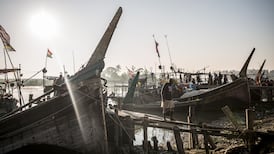Some encouraging news about birdlife on the island of Ireland landed last week. In Co Down, two breeding pairs of lapwings were spotted in a special area of conservation just outside Downpatrick, thanks to the efforts of a farmer, John Crea, working with Ulster Wildlife. Well done to both parties, who have demonstrated how collaborations such as these can centre thoughtful farmers in conservation.
Farmers need much more financial and logistical support to assist in making birds safe in their natural habitats and creating long-lasting breeding sites.
Recently in the midlands, a young crane took its first flight with its parents from rewetted peatland. There have been two other sightings of crane pairs in Offaly and Tipperary, also on rewetted bogs. This is progress. It is about 300 years since cranes have been in Ireland. Restoration and conservation works. It’s time to step it up.
In addition to this, for the first time in more than a decade, the number of corncrakes recorded in Ireland has exceeded 200. It has also been a bumper breeding season for barn owls, with Bird Watch Ireland recording broods of nests in Wexford, Kilkenny, Clare, Limerick and Offaly for the first time.
READ MORE
Like many people, my relationship with birds deepened during the pandemic. I found myself becoming more attuned to the nesting sites of herons, and over the course of a few nights in the Phoenix Park in Dublin I waited for and witnessed the incredible scenes of long-eared owls, old and young, swooping in the darkness.
Recording birdsong
For the past two summers, I’ve been hosting talks with the ornithologist Seán Ronayne at the Beyond the Pale festival in Wicklow, events that culminate in Ronayne leading a birdwatching walk on the site. Ronayne is a remarkable young ornithologist from Cork, whom I encountered through a video report by the brilliant documentary-maker Kathleen Harris, made for irishtimes.com. He is nearing the completion of a vast project recording the birdsong of every species on the island of Ireland.
[ ‘My mission is to record all of the bird species in Ireland’Opens in new window ]
What’s extraordinary about those birdwatching walks is the instant, rich learning people gain from building a new connection with their immediate environment. This type of immersive, interactive education is something schools across the country should engage more in. It would benefit adults too. Some of us will have memories of nature walks with teachers as children, but this holistic approach tends to evaporate when the race for exam points and test scores drops in.
When we were last speaking in June, Ronayne had four species left to record: hen harrier, grey partridge, great skua and red-breasted merganser. Last Friday, I phoned him to see how he was getting on. “Funny you should ask,” he said, having been up since 4am surveying, “You know I’ve had a really difficult time with the hen harrier. It’s a nightmare. I’ve tried so many times. I had a recorder in situ and collected it today. The first file had a hen harrier recording right next to the microphone. It’s the first recording ever of a hen harrier in Ireland.”
Ireland is experiencing multifaceted ecological catastrophes that are condemning bird species to extinction
It’s a spectacular win for Ronayne, but in Ireland the days of this species are numbered. “The population is in free-fall,” he said, “They’re not self-sustaining any more. The natural mortality rate outweighs their survival. The population is doomed. The biggest factor with hen harriers is the upland habitats have been completely taken over by coniferous [Sitka] plantations. All of those conifer plantations that were upland peat would need to be rehabilitated fast . And we need to remove sheep from special protection areas. How are we allowing these crazy numbers of sheep in our national parks?”
Ronayne is understandably pleased about the news about the crane fledgling, but Ireland is experiencing multifaceted ecological catastrophes that are condemning bird species to extinction. Of the ring ouzel, he speaks of a pair “clinging on” in the north of the country. “This would have been a species ingrained in our landscape. Now it’s a sound completely unknown to people. That species could be extinct next year, and no one would know about it. Isn’t that sad?”
The prospect of cranes returning to Ireland in a meaningful way is tantalising. The crane’s presence is part of our understanding of ourselves on this land, core in elements of mythology, divinity and concepts of transition. The crane’s extinction in Ireland was instigated directly by the draining of bog and wetlands.
Functioning ecosystems
Habitat is everything. Small gains are beautiful, but we need to work towards a point where wild ecosystems function top to bottom, with all the fungus, plants, trees, birds and animals – including top predators – in harmony. We know from these small victories with the crane and the lapwing, exactly what needs to be done. What works in a small way can also work at scale.
Neither we nor the birds can live on crumbs. We are part of nature too, so we don’t just owe it to the land to embark on this replenishing, we owe it also to ourselves. We need to create a new legacy where the precious survival of a few birds can expand to thriving flocks.













